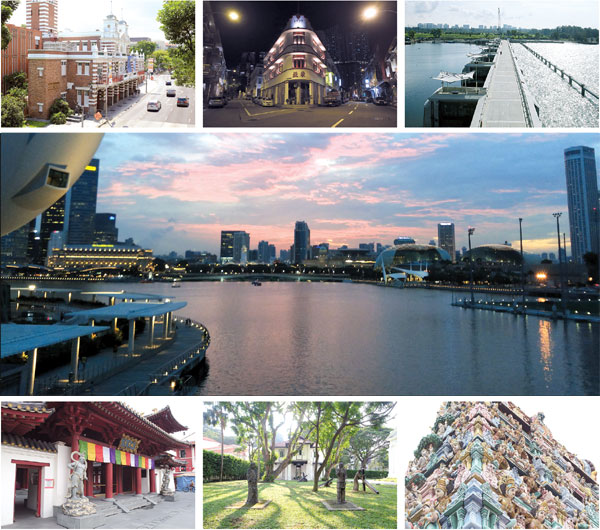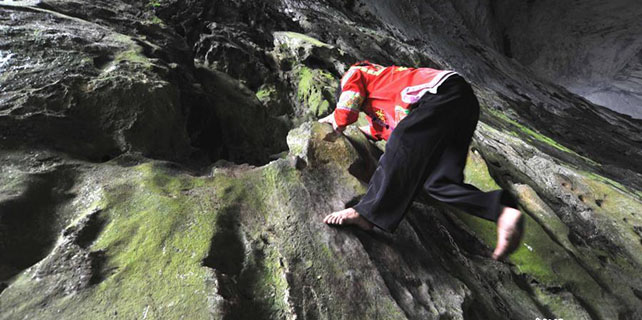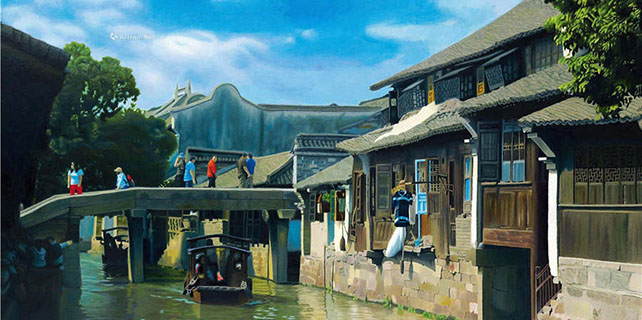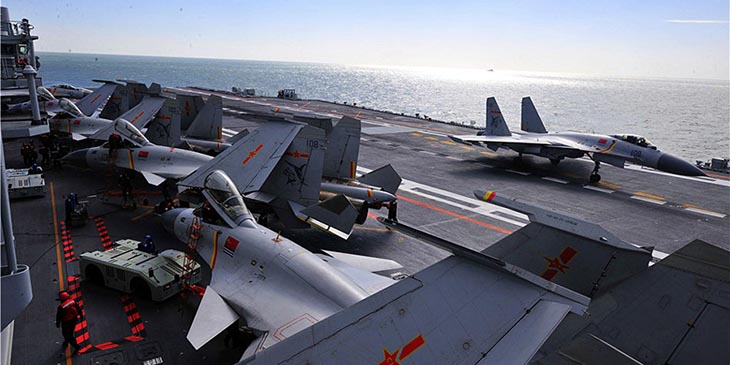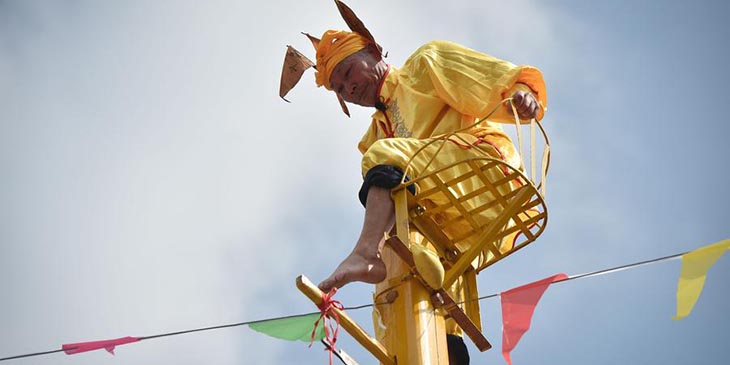Beyond the shining surface, a place like home
The minute city-state where migrants chose to gather
Like most important port cities around the world, Singapore's history largely boils down to two words: water and immigration. In fact, those words have been central to this droplet of land since long before it became Singapore and have continued to be so decades since it became the garden city-state that it is known as today.
"Despite sitting on the shore of the ocean, we are a resource-scarce nation when it comes to fresh drinking water," says Tan Ying Hao, senior manager from Singapore's Catchment & Waterways Department. "Throughout the 1970s, 80s and 90s, Singapore imported more than 70 percent of its fresh water consumption from Malaysia. The proportion is now 50 percent."
|
Clockwise from top left: Central Fire Station; China Town at night; Marina Barrage; Marina Bay; Sri Thendayuthapani Temple; Armenian Apostolic Church of St Gregory the Illuminator; Buddha Tooth Relic Temple. Photos Provided to China Daily |
One place to see the length Singaporeans have gone to to solve the problem is Marina Bay, one of the country's top sightseeing spots. In 2008 a S$226 million ($126 million) project turned the Marina Bay and the neighboring Kallang Basin into a new - and for the moment the only - downtown freshwater Marina Reservoir.
"The seawater in the reservoir had undergone a natural desalination process," Tan said. "It was constantly being flushed out into the sea as more rainwater filled the reservoir. The whole process went on for about one year and eight months."
A 350-meter-long barrage separates the reservoir to the north from the sea to its south. "On one side you see one of the world's busiest port, with an average of 900 ocean ship arriving in a single day," Tan said. "That's one every two minutes. On the other side extends this ripple-less, mirror-still surface of water that's slightly lighter blue. The catchment of the reservoir is 10,000 hectares, or about one-sixth of Singapore's total land area."
Pointing to a giant hoist standing on the eastern shore of the ocean, he said: "Water in the reservoir is not affected by ocean waves and therefore is considered ideal for various water sports including kayaking, sailing and water skiing.
"Ships can be lifted from the ocean and moved into the reservoir when people on board want to have fun there."
For casual travelers, a picnic on a nearby rooftop garden, against the soothing ocean view, may sum up what you can expect in Singapore, but there are many more dimensions to the country than that. A powerful component of its vitality is its scintillating mix of ethnicities, cultures and religions, the result of centuries of immigration.
I stayed at the New Majestic Hotel in Chinatown for the four days while I was in Singapore in mid-June. The area, covering about 0.9 square km, was where Chinese immigrants settled from the early 19th century to the mid-20th century.
Starting from the early 1980s the Government of Singapore began to gradually renovate the area, with one of its overarching concerns being to preserve local history. Many age-old houses, including the hotel premises, were designated conservation buildings and put under protection. Today the area has an estimated 1,600 residents and a total of 1,200 conservation buildings.
Lyndel Joyce, the hotel's marketing communications executive, said that anyone in the know will always quickly get a whiff of the history in this part of town.
"Steps away from Bukit Pasoh Road, where our hotel is located, is another street known in the 1950s and 60s as the 'mistress street'," she said. "Also not far way was police quarters. There used to be a lot of clans within the Chinese community in Singapore. Feuding sometimes took place and required police intervention."
All the grittiness associated with that history are now mere vestiges, many old buildings that used to house the clan associations now housing design companies and art groups.
Down the road from the hotel is the Ee Hoe Hean Club (the name means the House of Harmony) one of the oldest millionaires' clubs in Singapore. It was at the club, founded in 1895, that rich Chinese businessmen networked, and it became the headquarters of overseas Chinese who provided financial help to resistance forces during the Japanese invasion of China between 1937 and 1945. According to Joyce, the building still functions as a gathering place for the rich.
About 100 meters further down the road and across the street is a self-branded store selling handmademade bags using authentic crocodile or ostrich leather. I peeked through the window for several nights running as I walked past the shop to the hotel. For those who are interested, the shop opens late and closes early.
If the design companies and fashion boutiques are any indicator, this area is fast gentrifying. However, walking for no more than 15 minutes, past antique shops selling jadeware and traditional Chinese doctors' clinics, you arrive at the heart of the old Chinatown, marked by the three-story Chinatown Complex.

The basement of the complex is filled with little stalls selling vegetables and sea produce, including a type of hard-shelled crab - so hard that when it came in red curry the night before I left Singapore, I had to use a pair of pincers.
The second and top floor is reserved for hawkers of street food who are not allowed to spill out onto the country's pristine streets. (That's why Singapore has many hawker centers.) The fish balls, hand-pounded, tight and spongy, are not to be missed.
According to Chu King Fong, my tour guide and a second-generation Chinese immigrant, these days Chinese account for 74.3 percent of Singapore's population, with Malays making up another 13.3 percent. "Another 9.1 percent goes to the Indians. And then there's the Eurasians - people born from marriages between Asians and Europeans," Chu said.
"Raffles, who turned Singapore into a British colony in the early 19th century, adopted a policy of segregation when it came to town planning," she said, referring to Sir Thomas Stamford Raffles (1781-1826), a British statesman and conqueror whom some credit with the founding of modern Singapore.
In 1822, three years after Raffles arrived in Singapore, he implemented the Raffles Town Plan to tackle growing disorderliness in the colony. Under the plan, ethnic residential areas were subdivided into four areas. The European Town had residents made up of European traders, Eurasians and rich Asians, while the ethnic Chinese were located in present-day Chinatown and southeast of the Singapore River. Ethnic Indians resided at Chulia Kampong north of Chinatown, and Kampong Glam consisted of Muslims, ethnic Malays and Arabs who had immigrated to Singapore.
"Since the founding of Singapore in 1965, the government has taken aggressive measures to build a multiethnic society with a high level of inclusion for all groups," Chu says. The policy is best illustrated by the country's public housing system: apartments from one building must be allocated to applicants from different ethnic groups according to a certain percentage.
Steps away from where I stayed, the New Majestic Hotel, is Singapore's tallest public housing project, The Pinnacle@Duxton. While its towering height - there are 50 stories in total - and ultramodern design may give the impression of a deluxe residential building, it is in fact for wage-earners. One day I walked past its foot under the canopy of night, at the end of another day of interviews, and looked up. Soft light emanated from each window.
For me that was the moment that Singapore, the ultraclean garden city-state, ceased being a world financial center and started being a place that makes me think about home.
Contact the writer at zhaoxu@chinadaily.com.cn
zhaoxu@chinadaily.com.cn
(China Daily USA 11/15/2016 page8)



